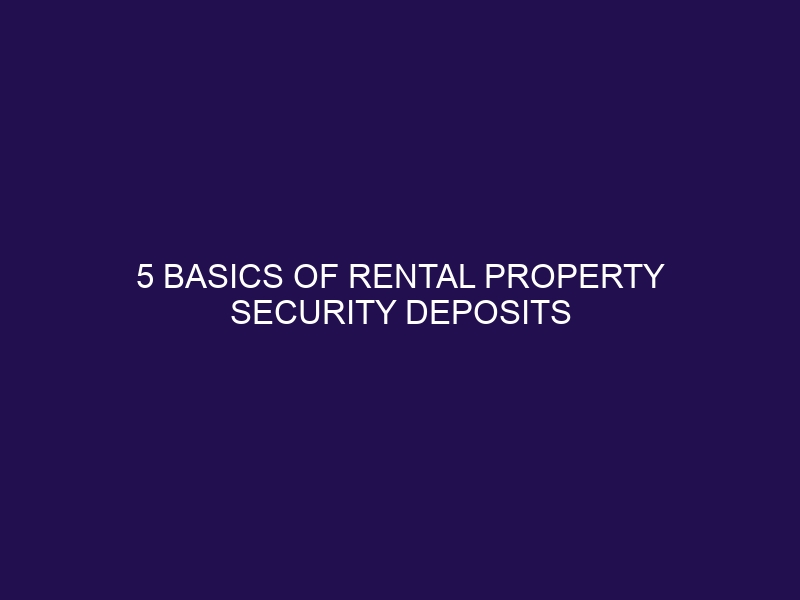5 Basics of Rental Property Security Deposits
A security deposit is a set amount of money that a landlord collects from a tenant before the tenant moves into a rental property. This deposit acts as a form of protection for the landlord in case of any damages or unpaid rent by the tenant. In Canada, security deposits are a common practice in the rental market, and understanding the basics of this process is crucial for both landlords and tenants.
The main purpose of a security deposit is to provide the landlord with financial security in case the tenant causes any damages or fails to pay rent. This deposit also serves as an incentive for tenants to maintain the property in good condition.
In Canada, the maximum amount that a landlord can charge for a security deposit varies by province. It typically ranges from one to two months’ rent. For example, in Ontario, a landlord can only charge up to one month’s rent as a security deposit.
The rules and regulations for security deposits in Canada are determined at the provincial level. However, there are some general guidelines that apply across the country. These include:
- Maximum Amount: As mentioned, the maximum amount a landlord can charge for a security deposit varies by province.
- Interest Rates: Some provinces, such as Saskatchewan and Quebec, require landlords to pay interest on the security deposit to the tenant.
- Timeframe for Return: In most provinces, landlords are required to return the security deposit within a certain timeframe after the end of the tenancy.
- Deductions from the Deposit: Landlords can only deduct certain expenses from the security deposit, such as unpaid rent or damages beyond normal wear and tear.
- Dispute Resolution: If there is a disagreement between the landlord and tenant about the security deposit, there are dispute resolution processes in place to resolve the issue.
To protect their security deposit, tenants should take the following steps:
- Document the Condition of the Rental Property: Before moving in, tenants should take photos or videos of the rental property’s condition and note any damages or issues.
- Keep Records of Communication with the Landlord: It’s important to have a written record of any communications with the landlord regarding the security deposit.
- Understand the Rules and Regulations: Tenants should familiarize themselves with the rules and regulations around security deposits in their province.
At the end of the tenancy, the security deposit should be returned to the tenant with any deductions for damages or unpaid rent. If there is a dispute, it can be resolved through the designated process in the province. Tenants should keep in mind that the security deposit is not meant to cover normal wear and tear, and they are entitled to receive their full deposit back if they have followed the terms of their lease agreement.
Key Takeaways:
What is a Security Deposit for Rental Properties?
A security deposit for rental properties is a sum of money provided by a tenant to a landlord before moving in. This serves as a safeguard for the landlord in case of property damage or unpaid rent. In some states, it is required for landlords to place security deposits in separate accounts.
What is the Purpose of a Security Deposit?
The purpose of a security deposit is to serve as a safeguard for landlords against property damage or unpaid rent. It acts as a financial safety net for landlords in the event that tenants are unable to fulfill their obligations. This practice dates back to ancient Roman law, where tenants would pay a deposit to cover any potential damages.
How Much Can a Landlord Charge for a Security Deposit?
- Be sure to check local regulations to determine the maximum security deposit allowed.
- Calculate the deposit amount based on factors such as monthly rent and state laws.
- Clearly outline the deposit amount in the lease agreement.
- Keep the deposit in a separate account as required by law.
- Provide a written receipt for the security deposit.
What are the Rules for Security Deposits in Canada?
As a tenant in Canada, it is important to understand the rules and regulations surrounding security deposits. These deposits serve as a form of protection for landlords in case of damage or unpaid rent. However, there are specific guidelines that must be followed when it comes to the maximum amount, interest rates, timeframe for return, and deductions from the deposit. Additionally, it is crucial to keep records of communication with the landlord and to understand the dispute resolution process in case of any disagreements. Let’s explore the key rules for security deposits in Canada.
1. Maximum Amount
- Before setting a security deposit, check local regulations to determine the maximum amount allowed.
- It is important to ensure compliance with the legal limit in order to avoid any potential disputes.
- Consider the condition of the rental property when assessing the appropriate amount for the security deposit.
True story: In Toronto, a tenant was recently successful in a dispute over an excessive security deposit by referencing the maximum amount set by the Residential Tenancies Act.
2. Interest Rates
- Check the local laws for any regulations on interest rates that may apply to security deposits.
- Verify the allowed interest rate for security deposits in the specific province or territory.
- Be sure to keep documentation of the interest accrued on the security deposit for transparency.
3. Timeframe for Return
- Know the Legal Timeframe: Familiarize yourself with the local laws specifying the timeframe for return of the security deposit.
- Request Receipt: Ask for a receipt when submitting the security deposit to ensure proof of payment.
- Communicate: Stay in touch with the landlord to discuss the return process and avoid misunderstandings.
Pro-tip: Take photos of the property before moving in and prior to leaving to support your deposit refund claims.
4. Deductions from the Deposit
- Inspect the property for damages beyond normal wear and tear to determine valid deductions from the deposit.
- Document any deductions with photographic evidence and detailed descriptions to support the claim.
- Provide the tenant with an itemized list of deductions and the remaining deposit amount.
5. Dispute Resolution
- Communicate: Discuss any concerns or issues with the landlord to resolve disputes amicably.
- Evidence: Provide documentation and evidence to support your position and aid in dispute resolution.
- Legal Aid: Seek legal advice or mediation if necessary to help with dispute resolution.
It’s crucial to maintain open communication and gather evidence for a smooth dispute resolution process.
Document the Condition of the Rental Property
- Take photos of each room, documenting any pre-existing damage or signs of wear and tear.
- Create a comprehensive written report of the rental property’s condition, noting all appliances and fixtures.
- Utilize a move-in checklist to record the state of the unit, which should be signed by both the tenant and landlord.
2. Keep Records of Communication with the Landlord
- Make sure to keep a record of all written communication with the landlord, including emails, letters, and text messages.
- It is important to document all verbal communication as well. Consider sending a follow-up email summarizing the discussion.
- For added security, store all records securely and make backups to avoid losing any important evidence.
Pro-tip: Utilize a communication log to easily track and organize all interactions with the landlord.
3. Understand the Rules and Regulations
- Research Local Laws: Understand the Residential Tenancies Act to know your rights and the rules and regulations that apply to your tenancy.
- Review Lease Agreement: Scrutinize the lease for clauses related to security deposits and other important rules and regulations.
- Seek Clarification: If unsure, consult with the landlord or a legal professional to ensure you fully understand all of the rules and regulations outlined in the lease agreement.
What Happens to the Security Deposit at the End of the Tenancy?
As a landlord, one of the most important aspects of renting out a property is handling the security deposit. But what happens to this deposit at the end of the tenancy? In this section, we will discuss the possible outcomes for the security deposit, including the process for refunding it to the tenant, the allowed deductions for damages, and the steps for dispute resolution if necessary. Understanding these basics will ensure a smooth and fair process for both landlords and tenants.
1. Refund
- Ensure the property is clean and damage-free.
- Return all keys and access cards to the landlord.
- Provide a forwarding address for the refund of your deposit.
Pro-tip: Take photos or videos of the property’s condition before leaving to avoid any disputes over the refund.
2. Deductions for Damages
- Document damages: Take photos or videos to record the property’s condition before leaving.
- Report damages: Notify the landlord promptly to discuss the issues and potential deductions for damages.
- Repair responsibility: Understand the lease terms regarding the tenant’s responsibility for certain damages and potential deductions.
Pro-tip: Maintaining open communication with the landlord can help resolve potential disputes regarding deductions for damages.
3. Dispute Resolution
- Communicate: Discuss concerns with the landlord to seek an amicable solution.
- Review Lease Agreement: Understand terms related to dispute resolution.
- Seek Legal Advice: Consider consulting a lawyer specializing in dispute resolution for landlord-tenant issues.
Frequently Asked Questions
What is a security deposit and how does it protect landlords?
A security deposit is a refundable payment that tenants make when moving into a rental property. It serves as financial protection for landlords in case of any damages or unpaid rent caused by the tenant. This deposit is kept in a separate bank account and may be used for necessary repair costs or extended vacancies.
What are the top three incidents that landlords and tenants fight over in small claims court?
The top three issues that landlords and tenants typically disagree over in small claims court are security deposit deductions, tenant-caused property damage, and missed rent payments. It is important for both parties to understand their legal obligations and have clear communication to avoid these disputes.
Can a landlord charge for normal wear and tear on a rental property?
Yes, landlords can charge for excessive wear and tear on the property caused by the tenant. However, they cannot charge for natural deterioration or normal cleaning that is necessary for maintaining the rental unit. Each state may have different definitions of what is considered normal wear and tear, so it is important to check local landlord-tenant laws.
Can a landlord deduct for cleaning costs from a security deposit?
Landlords can deduct for cleaning costs if the tenant left the rental unit in an unreasonably dirty condition. However, they cannot deduct for light cleaning that is necessary for preparing the property for the next tenant. The lease agreement may specify what is considered excessive cleaning and the landlord should provide proof of the condition of the property before and after the tenant’s stay.
What should landlords do if a tenant causes damage to the property?
If a tenant causes damage to the rental property, landlords should document the damage with photos and keep them in the tenant’s file or an electronic folder. They can then deduct the necessary repair costs from the security deposit. If the cost of repairs exceeds the security deposit, landlords may pursue legal action to recover the rest of the funds.
Is it necessary for landlords to have a separate bank account for security deposits?
Most states require landlords to hold security deposits in a separate interest-bearing account. This is to protect the tenant’s money and ensure that it is available when they move out. Landlords should also be careful not to commingle security deposit funds with their own money, as this is not allowed by law.







